Baxter was lying in his bed in the living room while I was making lunch in the kitchen. Our almost 2-year-old daughter Ellie brought a miniature tea cup over to Baxter and offered him a drink. She followed it up with a small plastic plate of ‘Os’—magnetic letters she’d removed from the fridge.
Baxter perked up at the possibility of food, but his head sunk back down when he realized this was a toddler tea party—therefore no real tea. While he hasn’t mastered the art of drinking imaginary drinks or pretending to eat inedible foods, he has mastered tolerating the toddler.
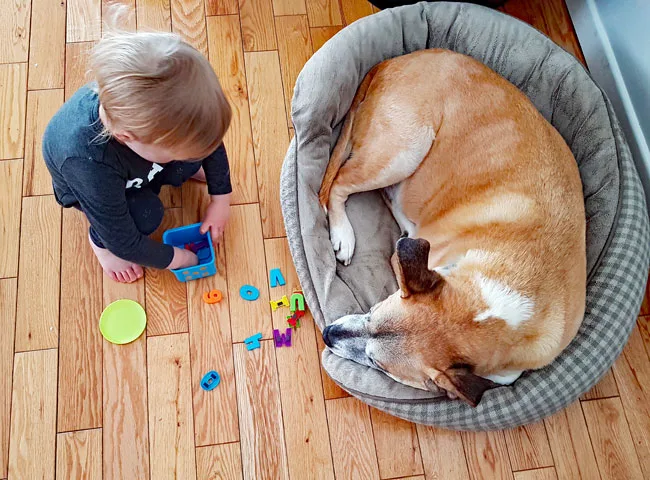
Today I’m sharing some tips for helping your dog and toddler live happily and safely together as well as an update on how Baxter is doing with our daughter as she turns 2.
I wrote a lot of different posts about how to prepare your dog for a baby during my pregnancy and early days with Ellie. Then last year at Ellie’s first birthday I wrote about how she and Baxter were getting along.
At that point, Baxter would occasionally growl at her and exhibited some anxious signs like licking or yawning. We were also still working with Ellie on polite dog behaviour, like giving him space and being gentle.
Now, a year later, they both have come so far and they have such a special bond.
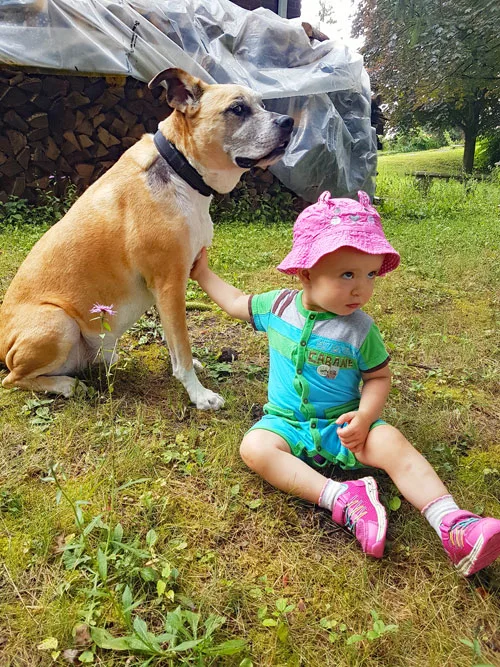
Baxter is super tolerant of Ellie, and I can’t remember the last time he growled. While Ellie isn’t always polite—some allowances are made for 2-year-olds—she cares about Baxter a lot and likes taking care of him.
How to help a toddler and dog get along
Here are some of the techniques we’ve used to create a positive and safe relationship for our toddler and dog.
1. Involve your toddler in dog care
Toddlers are becoming more capable and independent each day. They still need a lot of care and supervision, but they are able to participate in certain tasks related to your dog.
For Ellie, this means helping to feed Baxter meals and treats, getting his collar and leash when we’re going outside and occasionally helping to hold the leash on walks.
Ellie and Bax started going for walks together when she was just a few weeks old, so this is a regular routine for all of us and is a highlight of our days.
It’s also important to involve your dog in activities with your baby.
Baxter’s main hangout space and Ellie’s main play space are both the living room, so they spend a lot of time together every day, even if they’re not directly interacting. As Ellie has grown, her play has become more active, but Baxter has had lots of time to get used to the noise, motion and toys. Now, he does not react when a toy comes his way or a miniature shopping cart is pushed across the room at top speed.
Bax has also gone to the park and lounged under the playground while we’ve played. He hangs out around the table during mealtimes—though we are very vigilant to make sure he doesn’t eat from the floor or the baby. And he’ll occasionally attend story time in Ellie’s room.
Know your dog’s comfort level and find the activities that suit him best.
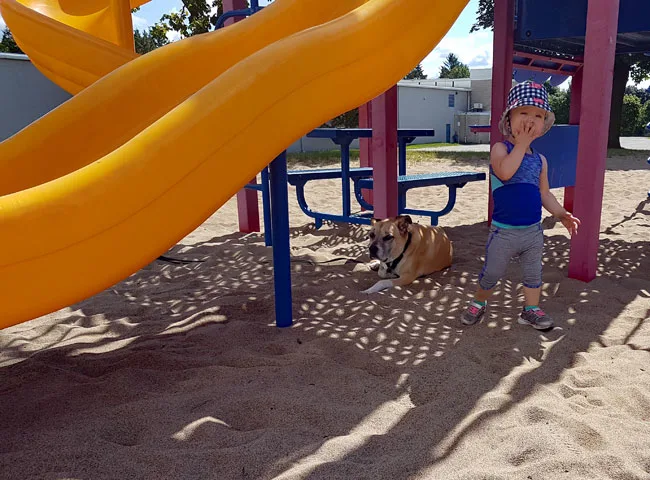
2. Separate your dog and your toddler when necessary
The flipside of giving dogs and toddlers opportunities to be together is that sometimes you need to separate them. Humans—no matter how old they are—and dogs each need their own time and their own space to feel safe and comfortable.
Most toddlers don’t have a great understanding of personal space, so it’s up to you to watch your child’s behaviour and your dog’s attitude and step in if necessary.
Baxter is very good about removing himself if he needs a break. He will go to our bedroom where we have a second dog bed. If Baxter walks away, I explain to Ellie that he’s sleepy and going to take a nap and try to get her interested in doing something else. As she’s grown, she’s become more tolerant of Baxter disengaging.
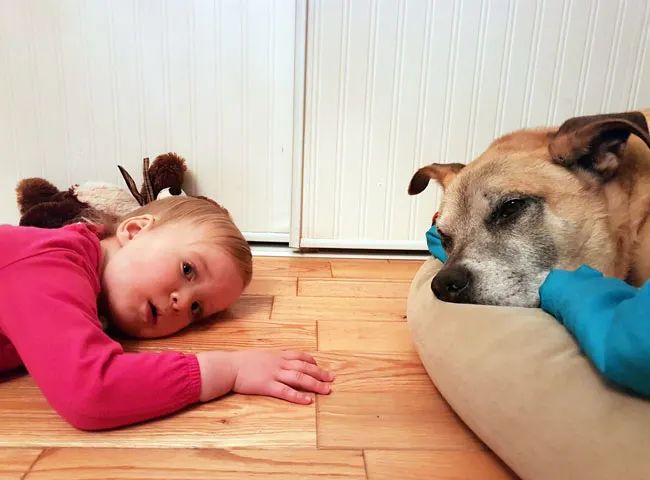
Depending on your dog’s temperament, he may need some help or encouragement to walk away. (And make sure he always has the option to get away.) Pay attention and don’t hesitate to separate your dog and toddler yourself if needed.
While Baxter’s bed and food areas were out of bounds initially, we have relaxed some of those rules as Ellie has gotten older and Baxter has gotten more comfortable.
Baxter is a very low energy dog, so he’s usually lying down in his bed. If Ellie wants to pet him, she doesn’t have much choice but to perch on the edge of his bed. I make sure petting sessions don’t last too long—the minuscule toddler attention span helps—and remind her to be gentle. We also make sure Ellie doesn’t crowd him when he’s eating or drinking.
On the flipside, we haven’t made any of Ellie’s spaces out of bounds. Baxter is welcome in her bedroom, on her playmat or beside her dinner chair. In fact, when we set up a new play area for her in the basement, Baxter wanted to be part of it, so we had to move a dog bed into the room so that he didn’t miss out.
I also make sure that Baxter gets attention throughout the day and some one-on-one time every day, with walks during Ellie’s afternoon nap and extra pets in the evening after she goes to bed.
3. Never leave your dog and toddler together unsupervised
One of my favourite pieces of advice from my baby prep series was pretend your dog is a swimming pool. Never leave your baby or toddler unattended. As far as Baxter and Ellie have come with each other, I’m careful to watch them and make sure they continue to get along.
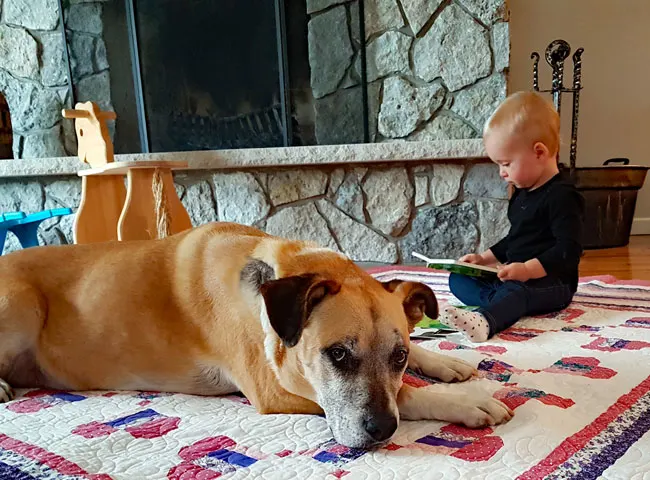
I feel very fortunate that Baxter is such a calm dog. No matter how excited Ellie gets, his default position is lying down.
We’ve visited other friends who have more energetic dogs. Ellie loves running and playing with the dogs, but it’s easy for both animal and toddler to get wound up. A toddler can get knocked over, a dog can jump or mouth. Depending on your dog’s energy level, you may have to be more vigilant in monitoring his interactions with your toddler.
Toddlers also don’t realize how obnoxious their behaviour can be. Ellie occasionally will say “beep” and try to push Baxter’s nose. Because I’m usually paying attention, I’m able to react quickly, stop the game immediately and explain that we don’t beep animals’ noses.
However, I am very grateful that Baxter does not react when she beeps him… or tries to brush his hair, or put a necklace on him, or feed him imaginary food or…
The tolerance Baxter has developed for Ellie also extends to other children. They can pet him, play around him, be noisy and rambunctious, and he will not react.
I’ve learned that Baxter’s preference is to keep an eye on what’s going on—and particularly Ellie if other people are here—but he does not want to participate. Therefore, I make sure that he gets lots of breaks and will redirect anyone who is giving him too much attention.
Know your dog and watch to make sure he is comfortable.
4. Spread the love – teaching your toddler compassion for all animals
Living with a dog at home can make your child more comfortable and compassionate to other people and animals.
The lessons Ellie has learned from Baxter have carried over and, I believe, made her a huge animal lover.
She is confident around animals and will greet cows, sheep, goats, horses—as well as the chinchilla, ferret, cockatoo, skunk, sugar glider, lizard and snake we saw at a recent exotic animal show—all with gentle pets.
We live across from a horse farm, and we often go visiting across the road. She stands on the fence and says, “Horsey, come!” On the days where they do eventually come, she stands quiet and still, lets them smell her and gently strokes their noses.
Our barn cat, Ralph, is perhaps Ellie’s favourite animal. From the start Ralph has been an outstanding babysitter. Before Ellie could walk, she would sit on the driveway and Ralph would twine herself around the baby, much to Ellie’s delight. Now Ellie loves to go to the barn to look for the “kitty.”
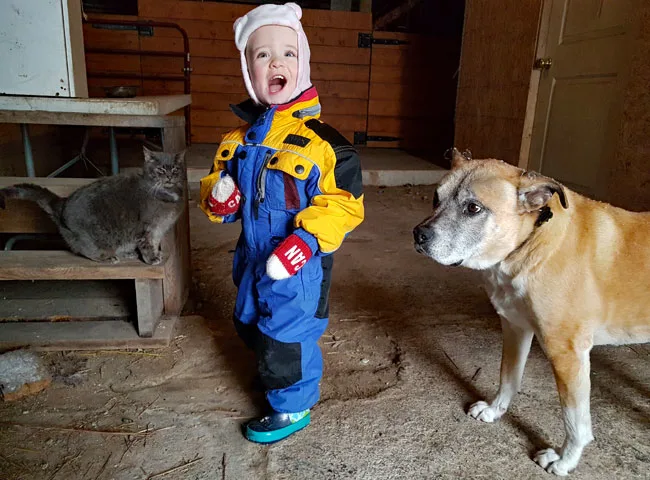
Ellie also understands that Ralph and Baxter need food and water and attention every day, and she’s learning patience and generosity as she takes care of them.
The relationship between a dog and child can be very challenging. But it can also be incredibly rewarding. I am very glad that Baxter has accepted Ellie and that Ellie has turned out to be such an animal lover. I hope that some of the tips I’ve shared may help other parents to create the same loving, caring family.
Do you have any advice for helping toddlers and dogs to live comfortably together?
Let us know in the comments.
How to help a dog and toddler live safely and happily together
- Many toddlers want to be involved in what you’re doing. Capitalize on their interest and find ways to let them “help” take care of your dog—with appropriate supervision, of course.
- Be prepared to separate your dog and toddler if needed. Have another bed or crate in another part of your house that your dog can access if he wants. Explain to your toddler that the dog is taking a break and distract her with a new activity.
- Spend time with your dog one-on-one. Toddlers can consume a lot of energy and time. Try to save some energy and time to make sure your dog gets enough attention.
- Supervise your dog and toddler. No matter how well-behaved they are or how good their relationship is, don’t leave your dog and child alone together.
- Introduce your toddler to other animals. Your toddler may not be a dog person… or she may love all animals. Help her learn about a variety of animals and discover what makes them each special.
Julia Thomson writes for That Mutt about dog behavior and training, working dogs and life on her farm in Ontario, Canada. She has a sweet, laid-back boxer mix named Baxter. She is also a blogger at Home on 129 Acres where she writes about her adventures of country living and DIY renovating.

Stacey Kline
Thursday 23rd of April 2020
This is a helpful post! Although my kids are grown now, this is beneficial for my nephews and nieces. They are at our house a few times a week. Thank you!
Colby
Thursday 19th of March 2020
Right before Emma was born we had 5 dogs: Linus, Stetson, Archer, Raven, and Bear. Archer is now working as a service dog. Bear was career changed and adopted. Linus and Stetson passed. So, now we only have one dog, Raven. We've been lucky with our dogs as they've all done really well and have been very tolerant of the kids. Fortunately, for us we haven't had to do much training with the dogs, but we do make sure that the kids as they've gotten older respect the dogs.
One day we were dog sitting my in-laws dog, Yuki. Emma was sitting next to Yuki and she said "Yuki is my favorite dog." I said: "Emma, what about Raven?" She said: "Raven is my best buddy!"
Lindsay Stordahl
Thursday 19th of March 2020
Aww! I take it Emma is a dog lover!
Alison Cooke
Wednesday 18th of March 2020
Thank you for sharing your post on building your positive relationship with young Ellie and patient Baxter. I appreciate your photos and update of your continued story building your happy and safe toddler and dog family life. This is an important topic that I wish was more widely discussed and shared. Yes! Build the relationship, respect a dog's space and the ability to choose a quiet area, use a gate when needed, always supervise, and praise positive behavior. I wish every vet office had your nicely summarized tips available as a handout. I'll be sharing your delightful article. Reading your Lindsay & That Mutt posts make for a delightful day.
Lindsay Stordahl
Wednesday 18th of March 2020
Thank you, Alison!
Lindsay Stordahl
Thursday 5th of March 2020
I loved this post. Baxter is doing so well, and sounds like Ellie is doing pretty well with respecting Bax too. I also love how good Ralph is with Ellie! That is so cute. I can't believe how grown up Ellie seems already.